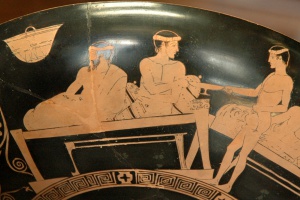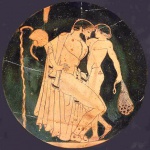Age-structured homosexuality

The modern symbol of boylove
Pederasty (from Greek paiderastia, love of boys) is used for
- the ancient Greek aristocratic custom of loving mentoring relationships between men and teen-age boys, whether sexualized or chaste (hebephilia).
- similar customs in other places and times by way of generalisation ;
- male homosexuality in general (and occasionally anal intercourse with either sex). This usage has dominated in the 15-.–20th centuries. It replaced the older term sodomy to avoid sodomy's religious connotations. In France pédérast is most commonly used for homosexual in general.
- Pederasty is often used interchangeably with the term boylove.
History

The original form of pederasty was a culturally sanctioned relationship originating in antiquity and particularly in ancient Greece, postulated to have originated in prehistoric Indo-European nomadic cultures. [Citation needed]a chapter in Male Intergenerational Intimacy, maybe? It took the form of an adult mentor and his pupil, who would be bonded together in a relationship of mutual love and in which the erotic attraction of the boy to his mentor was an important factor. The custom was commonplace in most Greek cities of the time, when intergenerational man/boy relationships were engaged in to bring important benefits to the community. The relationships were valued for giving rise to strong friendships, friendships which were thought valuable to democracies in particular. These relationships were also highly prized for the educational benefits they provided to the youth, and also for their positive effect in minimizing the then-current problem of overpopulation, which was keenly felt in many cities at that time. The custom was reflected in several popular myths and legends, most notably that of Zeus and Ganymede.
The theory and practice of pederasty was evident even into Roman times, until Christianity finally prevailed, and even then pederasty was commonplace for centuries more in varying forms, even (to some degree) until the present day.
An important note is that one did not need to have been primarily pedophilic in orientation to practice pederasty. Since man/boy relationships were a cultural mainstay, they were practiced by the majority of upper-class adult males.
Other culturally sanctioned forms of pederasty independently developed in many cultures throughout the world and has been seen in many tribal groups.[1] See Category:Japan and Category:Ethnic groups
Culture
Another important consideration are the labels "homosexual" vs. "heterosexual". These labels did not apply to sexual practices in pre-modern times. Some cultures today still differ in their opinions regarding male/male sexual relations. In particular, one article cites the sexual relationships of adolescent boys in Swaziland. The practice is seen as a way of "becoming a man". But in recent years, Western labels and ideals have been seeping into African cultures, causing conflict and resulting in declining male/male sexual activity.
- Some boys passed into manhood and got married but now and then they still need some man's wood to remain pure men," say's Mr Bhokondvo Nkosi, a Maths teacher of Emagogeni high school. "The difference before the Western influence is that it was ok to practice this type's of sexuality and now most African parents are considering it as "homosexuality" as it is labelled and therefore it is regarded as a silly influence from the civilised countries and as a Western disease." [2]
It's only fair to suppose that man/boy relationships could be regarded as one expression of this cultural ideal. Not until the Victorian era were the labels "homosexual" or "heterosexual" applied to human sexual activity, and this was due to the medicalization of human sexual activity.
References
See also
- Pederasty (dictionary)
- Ephebophile
- Situational homosexuality
- Boylover
- Sons - Norwegian film from 2006
- Psychiatry
- Medicalization
- Psychopathia Sexualis
- Psychopathia Sexualis Ch. V part 6
- Studies in the Psychology of Sex, Volume 2, Sexual Inversion (book)
External links
- Pederasty at thefullwiki.org
- Pederasty: Trending topics at thefullwiki.org
- Krafft-Ebing extracts (pp. 1-22, 407-430) from his work Psychopathia sexualis (1892 edition)
- Richard von Krafft-Ebing (External Wikipedia link)
